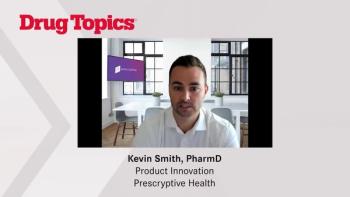
- Drug Topics November 2020
- Volume 165
- Issue 11
Understanding Pharmacy Management Tech Solutions
A look at how community pharmacies use EHRs and management systems.
Advancements in pharmacy management systems and increased usage of electronic medical records (EHRs) allow community and independent pharmacists to practice more clinically— beyond just dispensing medications.
Pharmacists already store information such as drug-dispensing histories that may not be available to other health care professionals. By making this information securely available to other health care providers through the EHR, pharmacists can contribute to a comprehensive overview of a patient’s medicine use, including medication adherence and persistence inferred from the frequency of dispensing.
Access to dispensing records and other drug-related histories also may facilitate effective and efficient medication reconciliation at transitions of care, such as admission to and discharge from the hospital.
Continuing to Evolve
Early pharmacy management systems essentially were designed for gathering lists of the prescriptions patients received. The systems didn’t connect with insurance companies, and there were few drug interaction checks.
“Today, a wide array of features within pharmacy management systems help pharmacists provide advanced clinical care, including diabetes management, weight management, and smoking cessation,” said Heidi Polek, RPh, a pharmacist and strategic program manager for DrFirst, a provider of innovative technology solutions that works with 67,000 pharmacies nationwide. “Pharmacy management systems also help pharmacists create electronic care plans that can be shared with patients and providers.”
For instance, a pharmacist looking at a patient’s profile will be reminded if they need immunizations. And when patients share important information such as blood pressure or cho- lesterol levels, pharmacy management systems now provide areas to save this information, allowing pharmacists to more completely assess a patient’s medication and health history. Ultimately, this enables more collaborative care between a pharmacist and a provider.
“Although e-prescribing is widely available, pharmacists still contend with the need to manually correct free text found in patient directions [known as sigs] for 84% of new prescriptions, which can lead to errors, take time away from patients, and slow down pharmacy productivity,” Polek said.
DrFirst is bringing technology driven by artificial intelligence to community pharmacies across the nation to help address this issue, which will improve safety and give pharmacists more time for patient counseling. SmartSig, which accurately translates 93% of patient directions, interprets electronic prescriptions as they enter a pharmacy system and fills in the information pharmacists typically type, minimizing the occurrence of misinterpretation or incorrect entry errors.
DrFirst works with multiple pharmacy system providers—including BestRx, Rx30, Computer-Rx, QS/1, and Speed Script—to enhance the clinical information gathered from patients and improve communication with health care teams, bridging gaps to help EHRs and pharmacy management systems “talk” with each other and enhance patient care.
Richard Scholz, RPh, chief strategy officer of ERxDirect, a platform of Health in Motion Network that offers the first fully virtually enabled independent pharmacy group in the United States, noted that community pharmacy has been a leader in adopting electronic pharmacy profiles dating back to the 1980s.
“The pharmacist utilizes the patient’s electronic pharmacy record to manage [adherence], check for drug-drug interactions, prevent duplicate or overlapping drug regimens, and check for drug-disease contraindications,” he said. “This clinical functionality is built into most pharmacy management software solutions to facilitate the pharmacist making clinical decisions.”
Unfortunately, community pharmacy has had limited visibility of the patient’s clinical EHR originating from the treating practitioners’ EHR system.
“The community pharmacist’s role has evolved through the addition of expanded clinical services, compounding, and specialty pharmacy clinical support,” Scholz said. “Each of these expanded clinical services is supported by the pharmacies’ [EHR]. The new opportunity is for patients to be capable of sharing any of their medical records within their care management team to improve coordination of care and optimize outcomes.”
ERxDirect provides a platform for member practitioners, pharmacists, and patients to securely communicate and seamlessly share medical records through the patient’s utilization of Health in Motion Network’s Total Health Engagement application.
“Physician group practice and health system EHR technology is evolving in a siloed, proprietary manner,” Scholz said. “Empowering patients to have access to those proprietary EHR-generated medical records and be capable of sharing the medical records with other members of the patient’s health care team is a valuable tool to expand patient understanding of their health challenges and treatment opportunities.”
Luis Rodriguez, president of Keycentrix, a pharmacy software and technology company, noted that the pressures of data collection, tracking performance metrics, direct and indirect remuneration, modern systems security, and shifting generational demographics are shaping demand and pushing pharmacies to further infuse technology into their operations.
“Pharmacies are leveraging mobile communications and tools to influence adherence, coordinate delivery, navigate a complex universe of benefits, and tie in the providers,” he said. “As this continues to evolve and sophisticate, expect to see major shifts in tried-and-true pharmacy operational models.”
Ketan Mehta, CEO of Micro Merchant Systems, said the company has several tools to help a pharmacist provide the best patient care possible.
“We have 2-way texting that gives the pharmacist a way to continue chatting with a patient and let them know when it’s time to take medication, and the system will automatically send a reminder to the patients,” Mehta said.
“There will also be reminders for refills and helping them through the automated refill process.”
The company also offers PrimeRxPAY, which allows a pharmacy to send a text message to the patient, then the patient pays for his or her copay remotely and in a secure manner, and the funds get deposited by the credit card processor, allowing the pharmacy to collect prescription copays from patients.
Once the credentials are provided to the pharmacy, they will be able to log on and view a patient by name or date of birth, and view the prescription profile. By default, PrimeRx pulls up the prescriptions filled in the last 30 days.
“Some of the newer technologies we are focused on are related to patient engagement,” Mehta said. “We are able to create a clinical assessment or questionnaire for the patient in the pharmacy system and then push it out to the patient. They provide feedback about their health and medications they are taking, allowing the pharmacist to focus on the clinical component and keep helping the patient to have better outcomes.”
EHR Challenges
One of the biggest barriers in adoption of newer EHR technology or any management system in the community pharmacy setting is a resistance to change.
“During the pandemic, however, pharmacists have had to change what has traditionally been a face-to-face model to keep their staff and patients safe,” Polek said.
Other barriers for community pharmacists to fully participate in expanded patient care management may be payer related, such as pharmacists being recognized as a provider by CMS, or financial constraints posed by transitioning resources to pharmacy care management.
According to Mehta, the new-age pharmacies opening up today understand the importance of synergy between these systems. However, many long-time pharmacists remain stuck in their ways.
“That model has to change,” he said. “On top of everything the pharmacists do, the mindset of moving along with technology can be challenging. Slowly, things are changing, but it’s important to utilize these tools for better health outcomes.”
Articles in this issue
about 5 years ago
CBD: A Look at the Legal Landscapeabout 5 years ago
Inpatient Pharmacy-Based Pain Management Service Improves Outcomesabout 5 years ago
Cancer Care In Transitionabout 5 years ago
Boosting Business With CBDabout 5 years ago
Cannabidiol (CBD) 101: Overview and Potential Interactionsabout 5 years ago
Use This Checklist To Select Your CBD Productabout 5 years ago
Educate Patients About Affordable, Accessible Insulin Optionsabout 5 years ago
Improving Pharmacist-Physician CollaborationNewsletter
Pharmacy practice is always changing. Stay ahead of the curve with the Drug Topics newsletter and get the latest drug information, industry trends, and patient care tips.











































































































































































































